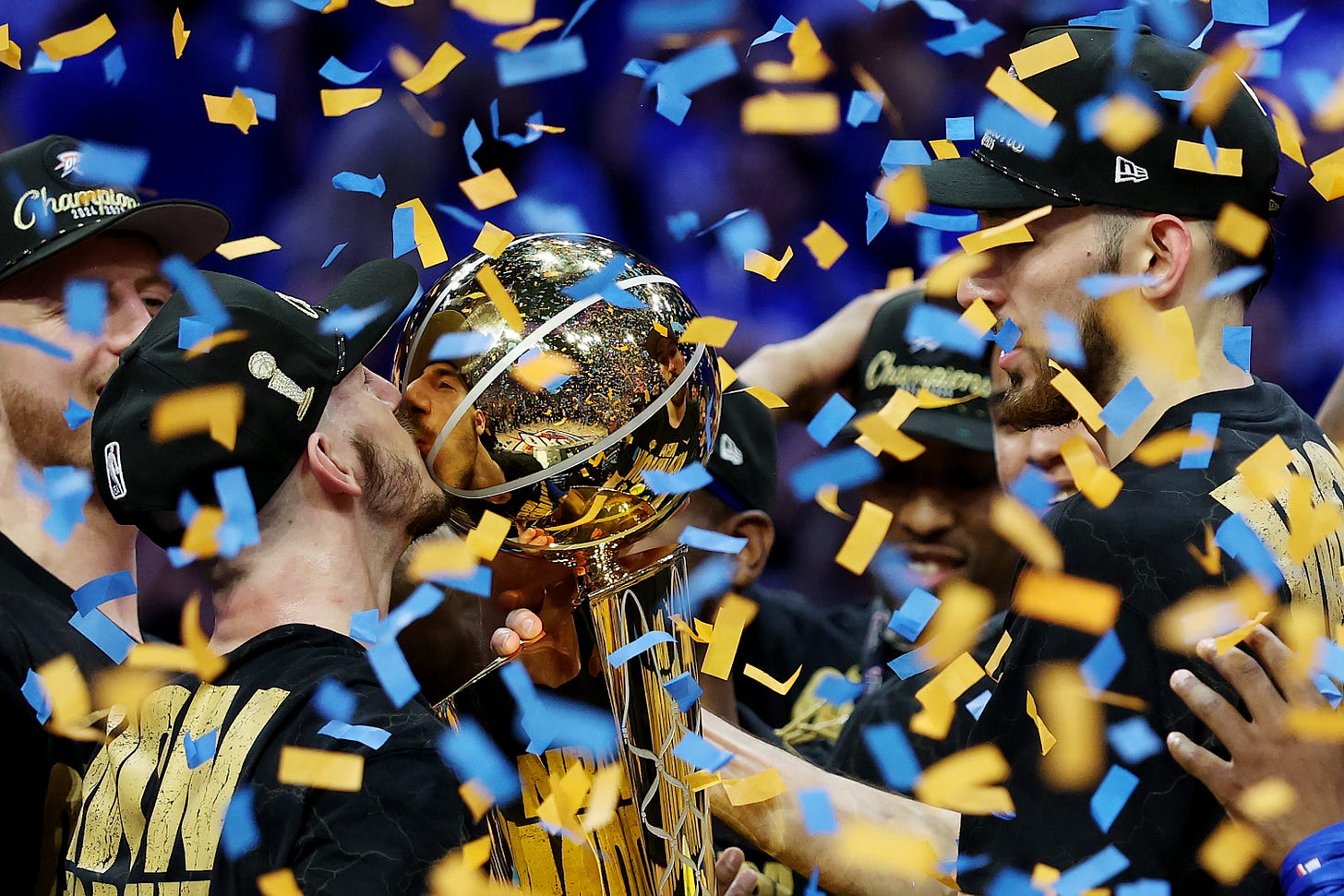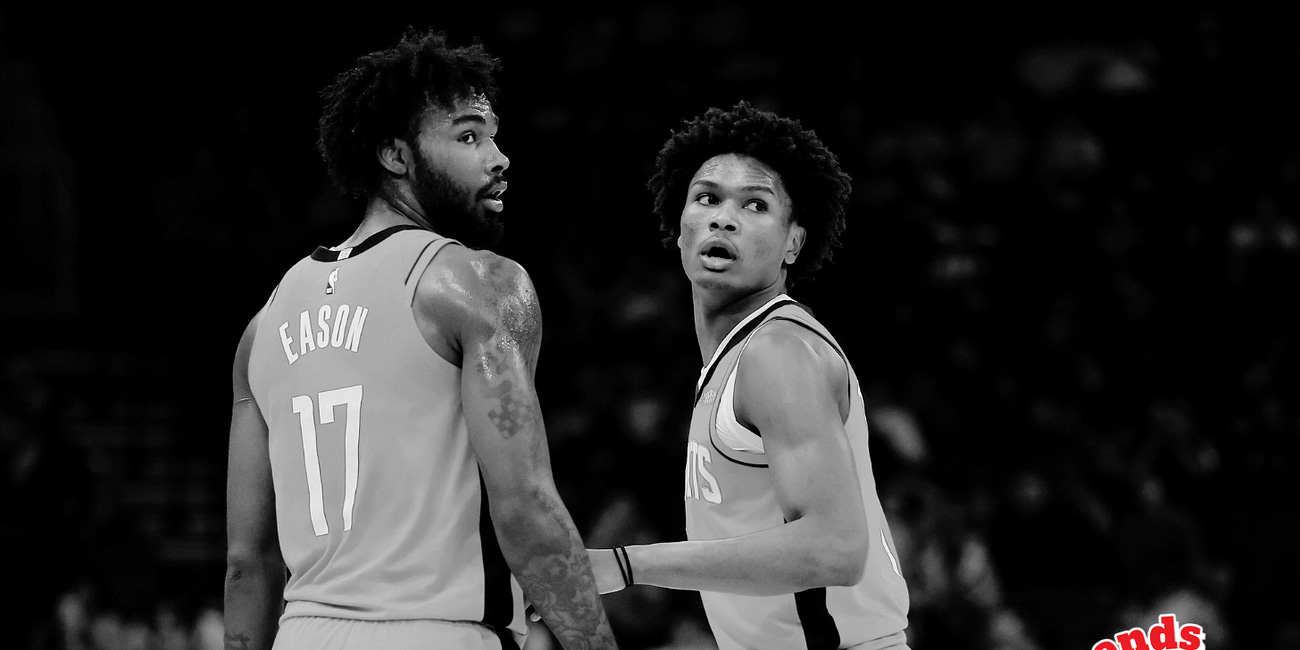The Copycat Aftermath of the NBA Finals
What the Thunder’s title means for the rest of the league?
The wild ride that was the 2024–25 NBA season has reached its end, and the Oklahoma City Thunder stand on top.
With a decisive Game 7 win, they’ve secured the franchise’s first championship and put an emphatic stamp on a dominant year. For the second season in a row, the best team in the regular season proved to be the best in the playoffs too—following the path set by last year’s 64-win Celtics, the 68-win Thunder put the last exclamation point on it in full-on Thunder style.
OKC’s offense didn’t look as impressive as last year’s Celtics, but it’s been their aggressive, relentless press, grab, and hold that’s thrown opponents off their game all season, and it was the difference once again in the final game.
The Thunder finished with a 14-turnover and 22 points off turnovers advantage, putting a cap on their historically unprecedented dominance in the turnover differential column across both the regular season and the playoffs. Like their style or not, there’s no doubt this Thunder team had a historically great run — combining regular season and playoff success with the accolades their leader, Finals MVP Shai Gilgeous-Alexander, picked up along the way.
EDIT: This is the final edition of what turned into a full season of game observations. We started this journey back in early October with Mavs preseason games. What now feels like a completely different time and universe shows just how quickly things can change in the NBA. Thank you to everyone who rocked with me throughout the season, reading the previews and observations 🙏
Today’s notes:
Who will follow the trends and try to replicate OKC’s blueprint?
A shift in rules skyrocketed the value of the perimeter disruptor archetype
Are the Rockets and Magic the next iterations?
Haliburton’s injury: The latest blow in a brutal trend
1-Who will follow the trends and try to replicate OKC’s blueprint?
Calling the NBA a copycat league is one of the biggest clichés around, but like most clichés, it holds a lot of truth. We’ve seen it time and time again. The Heat’s blueprint of loading up on three stars sparked imitations in Brooklyn, Philadelphia and Phoenix, though that model quickly ran into trouble under the new CBA. The Warriors made small-ball the league’s blueprint for nearly a decade, until the pendulum swung back toward size and interior dominance. After the Celtics lifted the trophy last year, teams like the Knicks followed suit—loading up on wings, leaning into a spread five-out offense, and in some other cases, pushing three-point volume to the extreme. Now, with OKC crowned champions, the question is how many teams will respond—or even overreact—to what just worked for the Thunder.
We won’t have to wait long for the answer. Two huge trades already went down during the Finals, and starting today, teams are allowed to negotiate with their own free agents and players eligible for rookie or veteran extensions ahead of July 6 (Lakers and Mavericks fans, you can find a detailed overview of your teams’ offseason milestones [here]).
Before the Finals, I wrote about some of the underlying trends that were clearly visible during this year’s playoffs. And if you looked closely at the data, you could already see where the league might be heading.
NBA Trends, Part I: The New Era of Speed, Athleticism, and Aggressiveness
We’re officially into offseason mode here at digginbasketball.
OKC and Indiana were two teams at the forefront of this new era of speed and aggression. With both reaching the final stage—and the Thunder winning it all—you can bet the rest of the league will reflect and, in many cases, recalibrate.
The pace, speed, and force the Thunder play with on defense was something even the fastest ball-moving offense in the league, the Pacers, couldn’t withstand in the end. That said, fighting speed with speed, combining it with skilled size and relentless offensive rebounding—another set of trends we saw emerge—got Indiana as close as it gets. And maybe, if Tyrese Haliburton’s devastating injury never happens, we’d be talking about it as the ultimate kryptonite.
2-A shift in rules skyrocketed the value of the perimeter disruptor archetype
Sam Presti has long been recognized as one of the smartest and most patient decision-makers in basketball. One of his guiding mantras has been that shortcuts cut long runs short. He followed that principle closely by building this OKC roster gradually and without high-profile swings, surrounding Shai Gilgeous-Alexander with fast, athletic and aggressive players.
Based on how he built the roster to that point, it’s hard to see it as a coincidence that Presti’s response to one of the bigger shifts in how the game is officiated that happened during last season, was to double down on defense and aggression by adding Alex Caruso and Isaiah Hartenstein in the following offseason.
The new level of physicality allowed on the perimeter has increased the value of the perimeter disruptor archetype. Presti loaded up on these types of players by finding Lu Dort as an undrafted gem in 2019, and later drafting Jalen Williams and Cason Wallace with two of the many lottery picks he had stockpiled over the years.
Keep reading with a 7-day free trial
Subscribe to digginbasketball to keep reading this post and get 7 days of free access to the full post archives.








